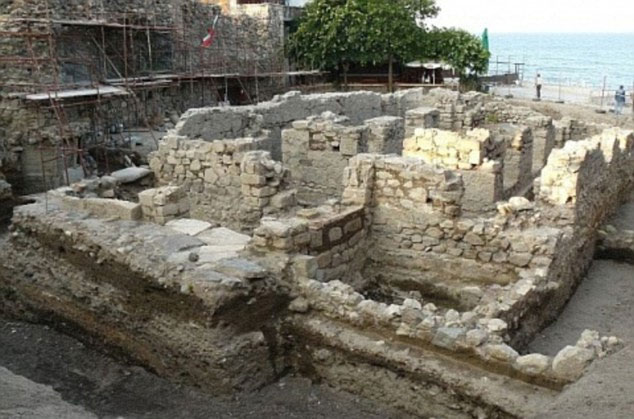Discovering the remains of
Archaeologists in Bulgaria have discovered two medieval 'vampire' skeletons with iron bars piercing their chests to prevent them from turning into "non-dead".
According to the Daily Mail, vampire suspicious skeletons are identified about 800 years old. They were discovered during an archaeological dig near a monastery in Bulgaria's Sozopol town on the Black Sea.


Archaeologists in Bulgaria dig up 2 bones ' ghosts
' 800 year old vampire' near a monastery in the town of Sozopol.
Bozhidar Dimitrov, director of the Bulgarian National Museum of History, said: 'Skeletons with chest-piercing bars represent a common practice in some Bulgarian villages until the first decade of the 20th century. '.
According to the beliefs of the heathen, those who are considered bad people while alive can turn into vampires after death, unless the body is stabbed with iron or wood bars into the chest before being buried. It is believed that iron or wood bars will pin the bad guys down to the grave, preventing them from awakening at midnight and threatening those who live.
According to Dimitrov historian, archaeologists have discovered a total of more than 100 'vampire' remains pierced through the chest across Bulgaria over the years. These 'vampires' are usually nobles and clergy.
'What's curious is that there are no women among them. The Middle Ages are not afraid of witches , "added Dimitrov.
However, last month, Italian researchers discovered what they believed to be the remains of a "vampire" in a mass grave in Venice. In particular, the remains were buried with a brick tucked between two jaws to prevent the female 'vampire' from eating the victims of an epidemic that swept through the city in the 16th century.
Matteo Borrini - an anthropologist from the University of Florence - identified, discovered on the small island of Lazzaretto Nuovo in Venice, the evidence of medieval belief that vampires are behind the spread of disease. , such as the mysterious disease known as the Black Death (actually a plague) that claimed one third of Europe's population.
Mr. Borrini declared: 'This is the first time archaeologists have succeeded in restoring a monastic ritual. This helps authenticate the way the vampire's legend was born.

A close-up of a "vampire" skeleton.
Mr. Borrini said that the continuous occurrence of European devastating epidemics in the years 1300 - 1700 has nurtured beliefs about vampires, mainly because at that time people did not understand the process of item. wash of corpses. When reopening mass graves, grave diggers can sometimes encounter swollen bodies because of the gas, hair still growing and blood dripping from the corpse and believe that these zombies still alive.
Some shrouds used to cover the face of the dead are often eaten by the bacteria in the mouth, revealing the corpses and vampires that are attributed to "shrouds."
Medieval medical and religious documents are still preserved, and vampires or "dead people" are believed to spread plague to absorb the remains of bodies until they are received. be strong enough to return to earth again. The Middle Ages believed that, in order to kill vampires, you need to take the shroud off their mouths and put in something that cannot be eaten like bricks.
Although the legend of blood-burial shrouds dates back thousands of years, the modern vampire character was actually born in Irish writer Bram Stoker's novel 'Dracula' , based on 1897. Eastern European folk tales in the 18th century.
- The erosion coast reveals six remains hundreds of years old
- Discovering a 2,000-year-old remains in a shipwreck in the Mediterranean
- Mysterious remains of women belong to another human species
- Discovering scary infant sacrifices in Tunisia
- Mexico studied 30 sets of ancient remains
- 97 5,000-year-old remains were deformed in a house of 20 square meters
- The 5,000-year-old fist couple remains in Russia
- 9,000-year-old remains reveal the collapse of the old city
- Dozens of remains in stone casket 1,600 years in Wales
- Egyptian remains 3300 years with the ring
- The 3,200-year-old remains have cancer
- Secrets of the 7,000-year-old 'shaman' female remains
 Discovered an ancient centipede fossil 99 million years old
Discovered an ancient centipede fossil 99 million years old Discovered bat-like dinosaurs in China
Discovered bat-like dinosaurs in China Discovered a 200-year-old bronze cannon of the coast
Discovered a 200-year-old bronze cannon of the coast Discover 305 million-year-old spider fossils
Discover 305 million-year-old spider fossils